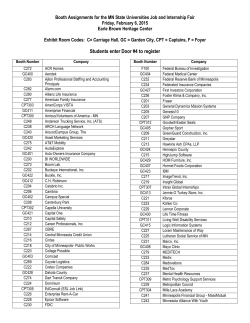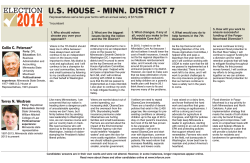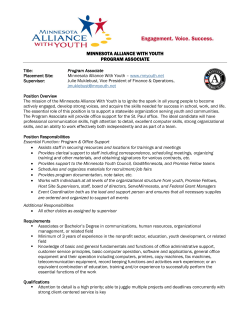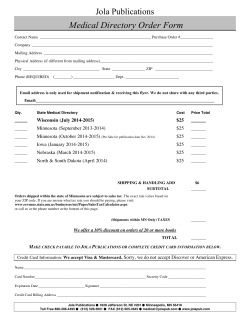
Making Sense of Health Care Reform
Making Sense of Health Care Reform Why We Still Need the Minnesota Health Plan The Minnesota Universal Health Care Coalition recognizes the recently enacted federal health reform legislation, the Patient Protection and Affordable Care Act, (PPACA) as a first step toward universal access to medical care. The federal bill is a political victory for advocates of reform because it affirms the principle of health care as a right and demonstrates that reform is possible. However, there is reason to be concerned about the PPACA’s ability to control costs given the example of Massachusetts which enacted a similar plan in 2006. The PPACA retains our administratively complex and fragmented system which costs too much, covers too little and leaves too many people without affordable access. The Minnesota Universal Health Care Coalition is committed to taking the necessary next steps to create a sustainable health care system that guarantees continuous affordable access to quality health care. We support the Minnesota Health Plan, a single-payer plan for ALL Minnesotans. Principles Overview Universal Coverage Equity of coverage Low administrative costs, health care dollars spent on health care The Federal Bill: Patient Protection and Affordable Care Act Builds on our system of private health insurers and employment based coverage; institutes a mandate to have insurance (or pay a penalty), provides subsidies for low income people and tax credits to small businesses to purchase coverage, creates insurance exchanges to shop for plans. Reforms some discriminatory practices of insurance companies. Estimates an additional 32 million people will get coverage. When fully implemented in 2019 it is estimated that 23 million Americans will still be uninsured, of whom half will be undocumented immigrants and half will be people who cannot afford coverage (and who either pay the penalty or are exempted due to financial hardship) Multiple plans available with varying benefit packages. Plans in the exchange must offer at least a basic defined benefit package. There will be 5 tiers of coverage. Access to care still largely determined by wealth and/ or employment. Will continue current complex multi-payer system where approximately 31 cents of every health care dollar goes to administration (marketing, billing, claims adjustment, credentialing, claims processing, utilization review, lobbying, profit, and large CEO salaries). Requires insurers spend no more than 15% (large plans)-20% (small plans) of premium revenue on administration and profit. Security of Coverage Employers remain a primary source of health care insurance; you can lose or be forced to change coverage with job loss, job change or retirement. There can be gaps in coverage. Typically requires annual reenrollment. Prevents insurance companies from dropping coverage when people get sick (unless evidence of fraud). Abolishes ability to exclude people based on preexisting conditions (beginning 2014) Requires insurers to allow children up to age 26 to stay on parents plan (must pay, of course) The Minnesota Health Plan Creates a single comprehensive plan for all Minnesotans (based on residency), paid for based on ability to pay. Covers 100% of Minnesotans. One comprehensive plan for all regardless of age, income, employment, or health history Markedly reduces complexity with one plan and one payer. Single-payer systems spend approximately 2-6 % of premium/revenue on administration. It is anticipated that the MN Health Plan will be the same Guaranteed continuous coverage cradle to grave, with no need for annual re-enrollment. Health care coverage is based on residency not employment. Principles Choice Comprehensive Benefits Promotes prevention and public health Affordability The Federal Bill: Patient Protection and Affordable Care Act If covered at work, still limited to plans that employer offers. If covered by an “exchange,” limited to plans offered in the exchange. Choice of provider is limited to those “in network” for insurer. Unclear what will be included in basic benefit package offered through exchanges. Current employer-based plans will remain as they are, which may be better or worse than the plans on the exchange. Significant expansion of community health centers sites. Eliminates co-pays for preventive services. Abolishes lifetime caps on coverage, by 2014 abolishes annual caps on coverage. Prohibits charging more based on gender (by 2017) or medical history. Allows for charging more based on tobacco use (1.5x higher) family size & age (up to 3x higher). Requires insurers to justify rate hikes (but doesn’t give government authority to regulate rate hikes) The Minnesota Health Plan Patient free to choose care provider from among all licensed providers in Minnesota. Covers all necessary medical (inpatient and outpatient), mental health, chemical dependency, dental, home health, and long term care. Covers prescription medication, medical equipment. Each Minnesotan has access to a provider of their choice. All necessary medical care, including preventive care, is covered. The MHP funds community prevention programs. Premiums will be based on ability to pay/income. Details not specified in current version of the legislation. Revenue modeling of other state singlepayer bills are based on a 7-8% income tax (in lieu of premiums, co-pays, & deductibles) Increases Medicaid eligibility to all individuals under age 65 with incomes up to 133% of federal poverty line. Affordability standards set in law, increase every year. Premium subsidies, based on income, up to 400% of federal poverty line (FPL= $18,310/yr for family of 3), subsidies to reduce out of pocket maximum for co-pays and deductibles. Provider/ patient decision making Quality Accountability and transparency Example based on subsidy levels and caps in law: Family of 3 at 300% FPL ($55,000/yr) would receive subsidy to cap premium at $5225/yr and co-pay and deductible out of pocket to $7973/yr; total health care spending could be as high as $13,198/yr (24% of income!) Although insurance companies can no longer rescind care (discontinue your policy when you become sick), or deny coverage based on pre-existing conditions, they can still deny claims. Supports comparative effectiveness research, and calls for development of “national quality improvement strategy.” For Medicare establishes several pilot programs to examine payment reform (pay for quality, bundled payments, etc). Collects data on racial, ethnic, gender, and geographic disparities. Retains private (nonprofit and for-profit) insurance companies. Private insurance companies primarily accountable to shareholders not patients. Theoretical example: family of 3 with adjusted gross income at 300% of FPL with a 7% health tax would pay $3850/yr , with an 8% income tax would pay $4394 (This would replace current premiums, copays, deductibles and out of network costs) Your health care provider has ultimate authority on what medical care is necessary for you. Assures continuity of care with choice of provider, stipulates care coordination, establishes Office of Health Quality and Planning. Addresses standards of care and evidence based practice. Governed by a health care board of regionallyelected officials, and appointed providers, business people and consumers. Separate from the legislature. Caps the compensation for Health Commissioners. Accountable to the people of Minnesota. Barrier and opportunity in federal bill: PPACA Section 1332 “Waiver for State Innovation” creates a pathway for the Minnesota Health Plan. Section 1332 allows states to apply for a waiver to the insurance exchange requirement in favor of an alternative state plan provided it meets or exceeds PPACA thresholds: covers at least as many state residents as the federal plan, has equal or better benefits as the federal plan, is at least as affordable – in terms of both premiums and cost-sharing and not increase the federal deficit. A single payer system such as the Minnesota Health Plan would satisfy these requirements. Currently Section 1332 prohibits waiver applications until 2017. For more information: Minnesota Universal Health Care Coalition 651-641-4073, www.muhcc.org 2469 University Ave W, Suite W150, St. Paul MN 55114 April 2010
© Copyright 2025





















